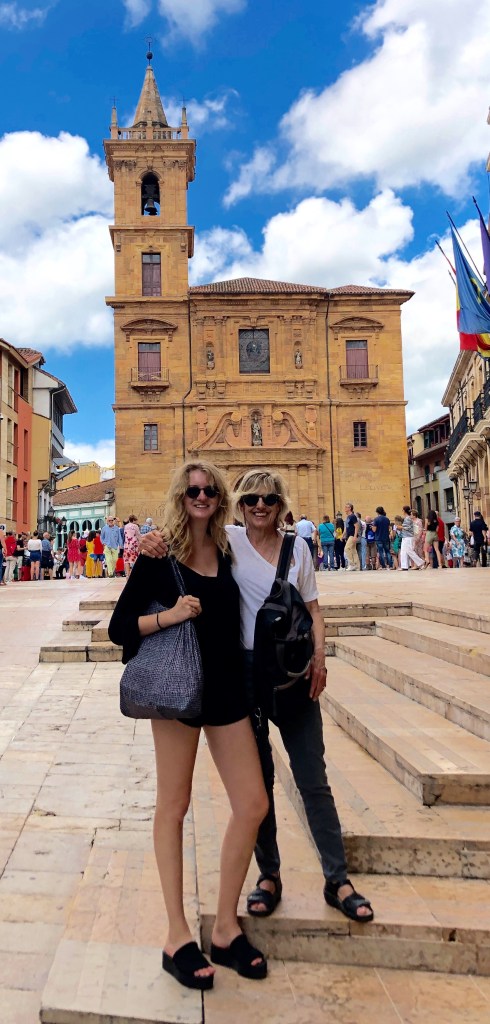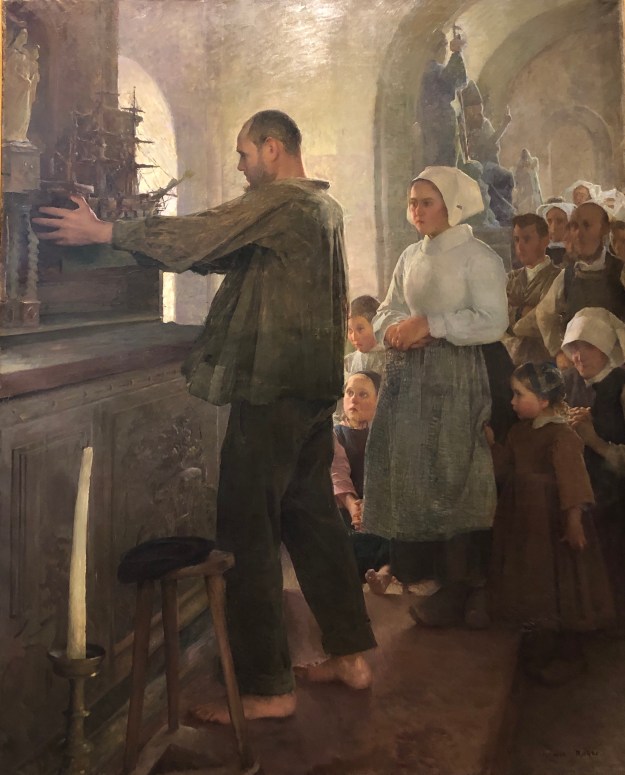Friday-Sunday, October 11-13, 2019
CARRARA
Thanks to Traci’s reassarch (and feeling a wee bit guilty due to their not being able to fit this in) we visited the marble quarries begun by the Romans in the Apuan mountains.

In order to reach the higest point in the quarries we needed to join a jeep tour. Our driver/guide appeared to enjoy his role–envision a mix of Arnold Schwarzenegger and Indiana Jones.

He entertained eight of us, including a young woman from Siberia who vaguely described her life as ‘moving around a lot’ (she had her own guide with her) and a Russian ballet dancer from the Kremlin and his wife, mother-in-law and 2-year-old son.
As our maniac driver cheerfully zoomed up the sketchy roads he told us families own individual plots and it was their equipment we saw on the different levels next to terraced cuts in the mountainsides. Yet, I later discovered online that the families weren’t the mom-and-pop variety but more like the Trumps and consortiums including foreign companies (such as the Bin Laden family).

We didn’t see any activity due to being after working hours, but our guide explained the process of carefully sawing and removing the slabs. No extracting going on allowed us to hear better as opposed to his shouting over the booming and drilling sounds of machinery. Although, I believe our guide would relish the challenge.
For over 2000 years men have worked these quarries, slicing into raw stone to deliver a range of marble, from white marble to a dark gray.

If you’ve read Irving Stone’s THE AGONY AND THE ECSTASY about Michaelangeo you’ve probably identified this as the marble source for the sculptor’s ‘David’. As well as material used by Henry Moore. Hey, if it’s good enough for Mikey, it must be good enough for any sculptor.
However, this systematic clawing away at these magnificent mountains may be ending. Some local folk have started the Salviamo le Alpi Apuane (Save the Apuan Alps) in the past couple of years to protest the desctruction of this natural landscape and the resulting air and water pollution from marble dust and waste. In the past year they actually succeeded in closing down two quarries (positive news keeping mountains alive ). A bit poetic in a mixed-up metaphorical way that ‘David’ originating from here has managed to fight this $333 million industry Goliath.
LUCCA
Like Pienza this Tuscan city had been added to our tour based on others’ recommendations. With its intact medieval wall and a historical center filled with stunning churches and stone streets it made for a delightful two-night stop.
We joined strollers, joggers and cyclists as we entered the old city and climbed to the top of its 2.6-mile wall. Once there I realized this felt as if I was on a lovely, tree-lined boulevard as opposed to on top of a defensive rock wall.

With our limited time we explored one of the main attractions: St. Martin’s Cathedral (or Duomo di Lucca). Like most churches in Europe this one’s history goes back centuries with the main building rebuilt in the 8th century to accommodate saintly relics with later enlargements and renovations occurring into the 15th century.
FYI: For those, like moi, who aren’t on familiar terms with saints, Saint Martin is noted for severing his cloak to give to a shivering beggar. Two statues document this deed, one inside and one outside,

although, I have to say it looks like he’s aiming to sever the begger’s neck, not the cloak.
The alternating light and dark marble creates a stunning visual bringing to mind a Moorish influence. And, not to be too cheeky but I loved the additional plaid pattern added to the scene thanks to someone’s unique BMW Mini.

Whenever I enter a huge church my eyes immediately go skyward, which is exactly what occurred here.

Yet, what brought them back to eye-level appeared in the left-hand side roughly half-way up the nave. There a screened-in gazebo held the Volto Santo (Holy Face) a sacred image (and money-maker), which drew thousands of pilgrims.

Supposedly, and you’re more than welcome to believe this, Nicodemus, who helped Joseph of Arimathea remove Jesus’ body from the cross, carved this figure, but not trusting himself to render Christ’s face faithfully, he left the face unfinished and went to sleep. Yet, when he woke up he realized an angel had completed his work. Uh-huh.
But, this was a boon to those looking for an item to generate funds, I mean, to worship.
Thanks to two Bishops (one on a pilgrimage to the Holy Land and one in Italy) who dreamt where this sacred statue should be displayed, legend states it landed in Lucca in 782. Hence, the rebuilding in the 8th century mentioned above. And, you can tell they liked playing dress-up with their religious figures for in the museum associated with the cathedral we saw some gold and jewel-encrusted apparel for the Volto Santo:
Experts date this work to the 13th century yet say it could be a copy of an 11th-century statue, which could be a copy of an even earlier piece: an 8th-century Syrian work. Whatever. It does look magnificent displayed in its glittery cage, and the cathedral is definitely worth a visit, including the side room housing the tomb of Ilaria del Carretto, (1379-1405), second wife of the powerful Luccan ruler, Paolo Guinigi (1372-1432).
You can climb the attached bell tower, and we set off to do so (with my muttering “I can do this” while trying not to look down through the metal steps to the floors below) and were rewarded with a bird’s-eye view of Lucca.

Back outside we entered the smaller church sharing the square with the cathedral: Church of Saints Giovanni and Reparata. This served as the original church that St. Martins replaced in 782.
Some murals caught my attention when walking up to the apse

but below us is what we really found interesting. An archeology excavation delineated four time periods from the Romans’ habitation in the 1st century through to the second half of the seventh century. The most complete consctruction being the mosaic room of the church is S. Reparata.

One other church, the Church of San Michele in Foro (‘in Foro’ because it sits in Lucc’as ancient forum)

we visited touched on an MDT where we saw the desicated face and hands of St. Zita (d.1272), patroness of domestic servants, who lived and worked in Lucca. She’s also an incorruptible saint meaning her body hasn’t deteriorated. Which I find quite a generous description.

The square on which this building stood also featured one of the coolest looking senior citizens I’ve seen, and one I wouldn’t mind emulating both in fashion and transportation styles.

A walking tour later in the afternoon guaranteed us a fuller picture of this city. Joining a group of other tourists we learned why the word ‘liberty’ strikes a strong chord in the city’s inhabitants. From the 12th century to the early 1800s Lucca remained unconquered (although some of this freedom was bought by paying off potential occupiers). This meant fending off its enemies from Pisa and Florence, including repulsing that pesky Medici family.
The city’s republican status remained until 1805 when Napoleon made his sister Elisa Duchess of Lucca and Princess of Piombino. She mandated a square be constructed mimicking a French one, which resulted in the only plaza in Lucca with trees.

Lucca’s initial wealth came from the silk and brocade trade. In the 1400s the city held 8,000 people and 3,000 looms. Unfortunately, that trade petered out but in the mid-1900s Lucca fostered a less prestigious, but definitely lucrative industry: making toilet paper. I guess that’s why some appears to be embossed with a brocade pattern…
Our guide pointed out out one of the many towers poking up from the medieval structures, one we had noticed earlier in the day had trees sprouting from it.

She explained the wealthiest family planted them to ensure they owned the tallest tower in the city. Due to a law regarding height restriction the family added trees , thus they followed the letter of the law, just not the spirit.
Continuing our guided walk we landed at the site of one of Lucca’s most notable figures, Giacomo Puccini (1858-1924) whose full name, by the way, is Giacomo Antonio Domenico Michele Secondo Maria Puccini. With ancestors serving as St. Martin’s Cathedral musical directors for two centuries Puccini came by his talent naturally.
A statue in a square close to his childhood home pays homage to the creator of notable operas whose names even I recognize: LA BOHÈME, TOSCA, AND MADAMA BUTTERFLY.

Not knowing opera but relishing the dramatic voices singing in them, I read later that those who do know opera point to Puccini as ‘the greatest exponent of operatic realism’ (www.britannica.com). Which, I think, means he ensured the audience connected to the story playing out on the stage.
The tour ended in Piazza Anfiteatro,

the former Roman amphitheater where we later returned for the locals’ refreshing apéritifs, one with campari and the other aperol.

But, our last stop turned into another musical treat when we happened upon an orchestra and chorus practicing in St. Martin’s for that evening’s free concert.
Perfect way to end our stay in Lucca.
Sunday-Wednesday, October 13-16, 2019
FLORENCE
We returned our rental car to Florence and took the convenient tram into Piazza Madonna degli Aldobrandini the locale of our hotel facing the Basilica S. Lorenzo & Medici Chapel. Not that you needed to really know that but it helps with pic below.

Once again we followed Ellen and Carter’s path by taking two excellent tours given by Artviva. Not only did our guide (we had Brenda for both) deliver informative facts in an engaging manner but she also shielded us from the feeling of being swamped and crushed by maurading tourists traveling solo, in pairs, and in packs of 20 or more. If we hadn’t availed ourselves of the company’s services I sincerely doubt we would have lasted more than an overnight in this city. Not that we also weren’t tourists adding to the claustophobic mass!

We thought we might visit the Duomo, whose dome we could make out from our hotel.

But, seeing the never-ending line we opted to simply admire its stunning exterior.
Florence offers such a gargantuum amount of splendid sites created by world reknown artists it’s overwhelming just to think of recounting the ones we saw. So, rather than flooding you with our memories I’ll just mention some that stood out from our tours with Brenda, one walking around the historical center and the other focused solely on the Uffizzi Gallery. [FYI: for those uninterested in art, etc., you’re better off skipping this.]
To understand Florence’s power as a city-state just say ‘Medici’ over and over and over for that’s whose presence, including their coat of arms (whose symbolic use of five red and one blue balls remain a mystery to this day), you see cast in stone on many buildings,

dominates the city’s history. Add in this wealthy family’s patronage of the arts and it’s not surprising Florence and the Renaissance are inexorably linked.
Below are some excerpts from our tours around Florence:
…Donato di Niccolò di Betto Bardi, aka Donatello (1386-1466), apprentice of Lorenzo Ghiberti (1381-1455) (known for the brass doors of the Duomo’s Baptistery-seen below from earlier walk),

shared the reputation with Michelangelo of being the best Renaissance sculptors. Brenda showed us two key elements contributing to this sculptor’s reputation: his use of perspective and the realistic wearing of garments. To explain she pointed out his St. Mark standing in a recess of the Orsanmichele Church, once the chapel for linen and craft guilds, now a museum. 
If viewed when the 7’9″ statue stands on the floor St. Mark appears out of proportion with short legs and long torso; yet, this changes into one of complete symmetry when looking up to the niche. And, the molding of the garments depicting an actual body underneath is a complete change from when clothes simply fell stiffly hiding any form underneath. Not being an art aficionado both are insights I never would have known.
But, Brenda went beyond the technical merits of a piece of art with a glimpse of the artist’s personality. She told us how the guild who commissioned this work initially-and saw it face-on in the sculptor’s studio-told Donatello it didn’t look right and needed corrections. The sculptor said let him work on it and then place it up high so they could see how it looked then. Well, he did nothing and when the time came to show them the revised sculpture, Donatello simply had it placed in the niche and when unveiled, the guild approved of the ‘changes’.
…Brenda led us to the Piazzo della Signoria (it’s the people-jammed square at beginning of this post). This is where Michelangelo’s original David used to stand before being moved inside to the Accademia Gallery and, gruesomely, the spot where Girolamo Savonarola, the fanatical Dominican monk, was hung and burned along with two associates. It’s also, where a large loggia holds a large group of statues. There Brenda mentioned one in particular, ‘The Abduction of a Sabine Woman’ by Giovanni da Bologna, aka Giambologna (1529-1608).

By using a spiraling effect to depict the trio’s emotions this flemish artist created a dynamic situation as your eyes follow the twisting action flowing from one figure to the next. She also mentioned the metal wiring found in part of the bodies, which protects the work from lightening strikes.
As we followed her through streets and into plazas Brenda pointed out quirky building details, such as small windows with doors found hip level. She said these openings were wine doors where wine was sold to the public.

The next day she guided us through the Uffizi, the awesome museum stuffed with European masterpieces from the Middle ages to the Modern period. Focusing on paintings Brenda selected key pieces epitomizing the Italian Renaissance. Furthermore, she managed to ensure we parked ourselves close enough to understand specific details of each work…
…how Leonardo’s angel (on the left) was considered better than his mentor’s (Andrea del Vercocchio) in The Baptism of Christ,

…that Sandro Botticelli’s (1445-1510) muse (Simonetta Vespucci, 1453-1476) depicted in Birth of Venus has a rather thick neck for such a delicate-featured woman, which is most likely due to using a nude male model for the body . (I tried loading a good photo of her but program on iPhone isn’t cooperating, but check out the painting online. once you’ve been told that it’s hard not to notice her brawny neck.)

…and, the fact that Michelangelo Merisi, aka Caravaggio (1571-1610) rebelled against established art by painting subjects exactly as he saw them: in Bacchus the young man has a ruddy face in contrast to his pale body and dirty fingers, features that are associated with a guy working in the fields as opposed to a lofty Roman god.

The building itself is a work of art constructed between 1560 and 1580. But, what’s quite unique is the Vasari Corridor, named after its architect, connecting the Medicis’ Palazzo Pitti (across the river) to Palazzo Vecchio, the government’s headquarters. You can see the visible start of it on the right-hand side in photo below. Evidently, if your structure was in the way of the Medici’s private corridor, tough luck. Hmmm, sounds like a wall going up in our country.

Unfortunately, this connector is closed to the public due to structural concerns, but we could see part of it running down the right side of the Arno River, then crossing over the shops on Ponte Vecchio. (Once across the river it becomes a tunnel.)
The Uffizi Originally served as bureaucrats’ offices (the literal translation of ‘uffizzi’) with the top floor used to show off the Medicis’ art stockpile. Eventually it became a museum in 1865 with one of the Medici heirs, Anna Maria Luisa de’ Medici (1667-1743), creating the Family Pact of 1737 ensuring the family’s collection would remain intact and in Florence. A gift that draws millions of people every year to this city.
Throughout both of our tours with Brenda her information brought this medieval city and its inhabitants to life. If anyone’s heading that way, we highly recommend signing up for Artviva tours.
Max and I returned to one of the sites we’d seen with Brenda, Bargello Museum, another wonderful museum where we found few tourists. Once a contains more famous Florentine and Italian art. One of these is Donatello’s David. It was the first free-standing bronze statue and the first male nude since those created by the Greeks over 2,000+ years ago.

However, the biggest impression of my time in that studio is Max’s comment regarding this David. While I was gazing at other sculptures Max quietly steps up to me and whispers in my ear, ‘doesn’t his butt look a bit low slung?’. Intrigued I walked back to the David to scrutinize his posterior.

I guess I can agree with him, yet, what it did is cause me to check out other Stoney or metallic behinds I happened to see, and probably not just here but in the future.
Another locale, The Basilica of Santa Croce, offered a chance to see the tombs of famous people, such as Galileo Galilei (1564-1642). Initially his remains weren’t allowed in the main part of the church due to a charge of heresy (disagreeing with the Catholic church’s dogma by saying the earth orbited the sun) In 1737 (during the Age of Enlightenment) he was reburied in a prominent part (left nave) less three fingers and a tooth.

And, Micaelangelo’s tomb is there, too.

Max later visited the Galileo Museum and saw that finger (a mini-MDT). (They say it’s his middle finger…)

We enjoyed several other Florentine views, both across the river:
a landscape reached by climbing a hill to land in the Piazzale Michelangelo,

and, a foodscape taken in a bistecca restaurant where we chomped our way through a carnivorous meal.
Later we heard how Traci and Smokey also partook of a similar meal, only they actually saw their cut of meat pre-cooking :)
 Just wish we could have shared a bistecca meal together
Just wish we could have shared a bistecca meal together
Well, since my computer died, iPad WP program crashed, and the phone keyboard is not my best typing platform i’ll stop writing.
But, there’s one more photo I know you’d love to see before I close …
ciao!






















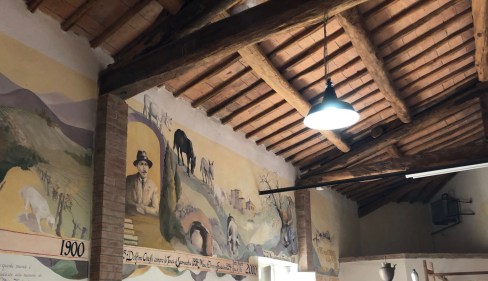






















































































































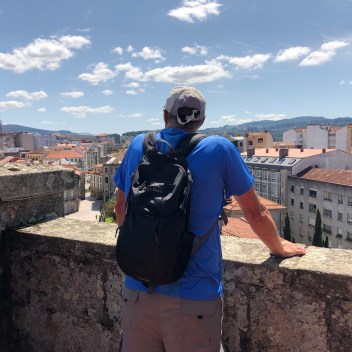

































 finally, a knight.
finally, a knight.



























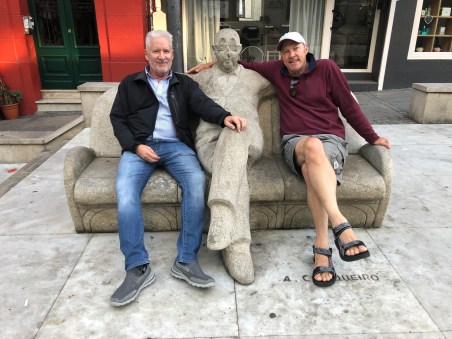







































































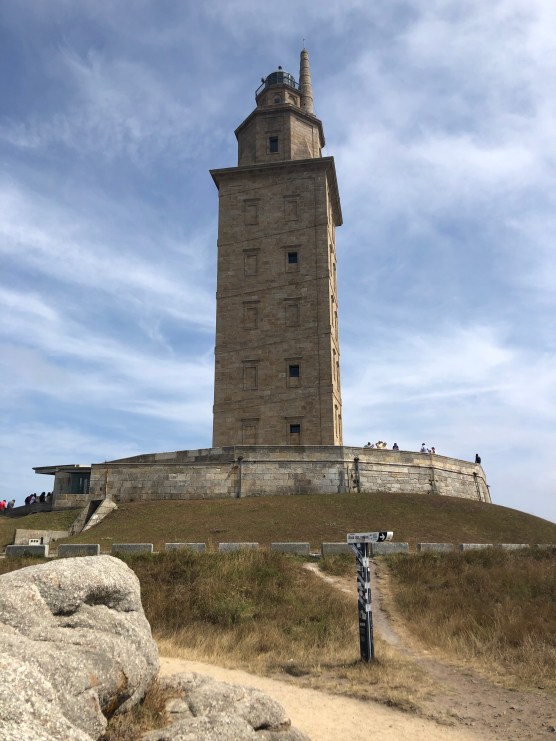



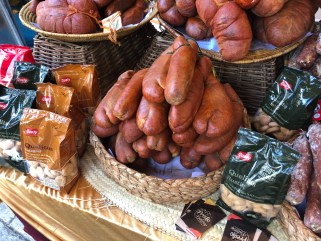



























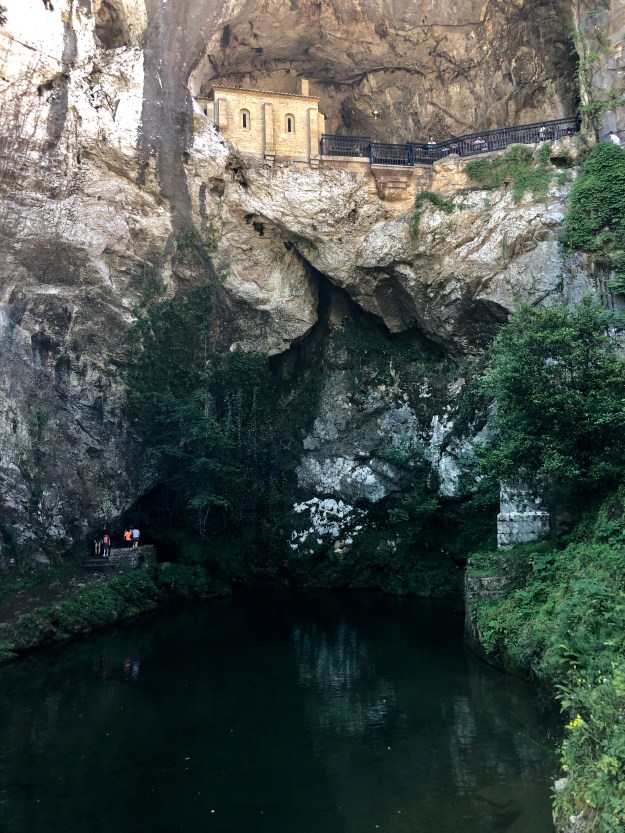










































 A display describes this king as one of the most prestigious figures of the Middle Ages. No doubt this reverance came from Louis’ devotion to the Christian faith (he’s the only French king named as a Saint). He wanted to trade his crown for a monk’s robe but knew his duty was to lead his people, which he did in the 7th and 8th crusades while spending boat loads of public funds on Christian relics (he built Sainte-Chapelle to hold these special items). Considering he zealously suppported the Inquisition, his reforming of the French legal system and the presumption of innocence seems a bit hypocritical. Eventually Luis got his halo and became Saint Luis in 1297.
A display describes this king as one of the most prestigious figures of the Middle Ages. No doubt this reverance came from Louis’ devotion to the Christian faith (he’s the only French king named as a Saint). He wanted to trade his crown for a monk’s robe but knew his duty was to lead his people, which he did in the 7th and 8th crusades while spending boat loads of public funds on Christian relics (he built Sainte-Chapelle to hold these special items). Considering he zealously suppported the Inquisition, his reforming of the French legal system and the presumption of innocence seems a bit hypocritical. Eventually Luis got his halo and became Saint Luis in 1297.



